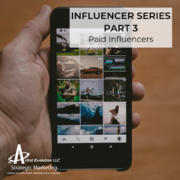Influencer Series, Part III: Paid Influencer Campaigns
Missed the first two parts of the series? You can find Part I HERE and Part II HERE!
In Part II of the Influencer series, we dived deep into the world of unpaid influencer campaigns.
What we learned is that for smaller companies, and especially startups with a product-centric business model, running an influencer campaign by giving away free products and discounts is a great way to quickly spread your brand’s market presence and potentially accelerate revenue.
However, unpaid influencer campaigns have their risks.
For one, controlling the quality of an unpaid influencer’s content is much more difficult than with their paid counterparts, and sometimes it’s impossible. Although you may gift your product to influencers, unless you have a contractual arrangement with them (common for ambassador programs) nothing is stopping them from negatively displaying your brand. This risk is especially prevalent if you’re working with a product-review style influencer.
Another potential risk with unpaid influencers is that gauging your ROI can be more difficult than doing so with established and professional paid influencers.
If your product suits a niche market, working with smaller, unpaid influencers may decrease the chances of you reaching your ideal audience because their followers may not follow them for the attribute you reached out to them for.
For example, say you give your product (a whey protein shake) to a micro-influencer who works out in the gym a lot and takes copious amounts of mirror selfies; you would assume the people following this influencer and liking his content would be gym rats, too, but it turns out this influencer just has a hyper-extroverted personality and has amassed a following more so on the basis of his personality (or six-pack) than his actual gym routine.
To avoid risks like these, many companies turn towards paid influencer campaigns.
With a paid influencer, you can control the terms of your partnership (e.g., endorsement frequency, promotion style, and even language or tone to an extent). This way you can practically eliminate the chances that your influencer’s following demographic doesn’t match your target demographic.
Paid influencer campaigns, though, just like any advertisement campaign, have inherently unavoidable risks. And minimizing these risks often equates to paying more money.
In order to maximize the potential of your paid influencer campaign, you have to find the right balance between quantity and quality. The most likely options available to you will either be to employ numerous micro-influencers (lower cost-per-endorsement) or a handful of macro-influencers (extremely high cost-per-endorsements).
So, unless you have the luxury of being able to employ numerous macro-influencers, understanding the price comparisons of various influencer levels is crucial for mapping out your campaign.
According to research conducted by DIGIDAY, these are the types of prices you can expect from modern paid influencers:
Instagram post:
- $1,000 per 100,000 followers
- (Or) $250 per post for micro-influencers with less than 50,000 followers.
Snapchat story:
- One to five thousand views = $500/story
- Five to ten thousand views = $1,000-$3,000/story
- Ten to twenty thousand views = $3,000-$5,000/story
- Thirty to fifty thousand views = $5,000-$10,000/story
- Fifty to one-hundred thousand views = $10,000-$30,000/story
YouTube:
- For YouTubers with more than 50,000 subscribers, marketers can expect to pay roughly $2,000 per 100,000 views per video, up until around 1 million subscribers, at which point a dedicated video could cost upwards of $25,000-$50,000.
- Endorsements can run anywhere from $200,000 to half a million per video depending on the extent of the endorsement.
As these numbers show, influencer campaigns can quickly add up depending on the quality of the influencer you are after and the type of platform you are targeting.
Mediums such as YouTube will inherently cost more because the amount of effort it takes influencers to integrate an endorsement into one’s existing content (without putting their viewers off) is much more considerable with video than on post-style platforms. Furthermore, due to the long-form nature of YouTube videos, viewers are more likely to trust influencers.
High-tier influencers can cost a considerable amount, but compared to traditional, old-school forms of influencer marketing (i.e., endorsements, commercials, etc.) the costs really aren’t that out of line.
Low-tier influencers are considerably more affordable, but due to their higher ROI risks you will want to employ multiple ones, meaning that you can easily find yourself spending just as much money.
So, let’s summarize…
When it comes to influencer campaigns, there are ultimately three routes you can take:
- Unpaid campaigns (high quantity, greater risk, but provides a point of entry into the market)
- Micro-influencer paid campaigns (high quantity, less risk than unpaid, point of entry into the market)
- Macro-influencer paid campaigns (typically low quantity, minimal risk, but expensive)
Balancing all these factors can be challenging, but when done right it can take your marketing efforts to the next level.
If you need consultation on influencer marketing, or a team of marketing experts to carry out an influencer campaign for you, The Artist Evolution is here to help.
Visit our website or send us an email to learn more!




